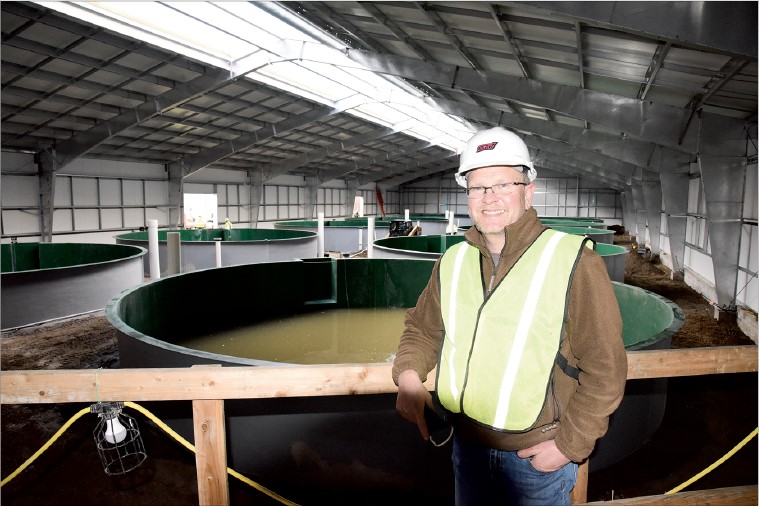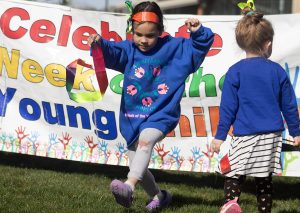By Wil Phinney of the CUJ
SOUTH FORK WALLA WALLA RIVER – A new fish hatchery, which is expected to produce some 500,000 spring Chinook salmon smolts, is nearing completion on the South Fork Walla Walla River about 10 miles southeast of Milton-Freewater.
It eventually will provide hatchery-raised fingerlings for the Walla Walla Basin.
The Confederated Tribes of the Umatilla Indian Reservation (CTUIR) expect to commission the new facility by the end of next May. Plans call for hiring a hatchery manager in early 2021, who will oversee four others that will live in one of three new residences being built as part of the project.
The project expands on a holding facility built in 1996 for spawning adults by adding key hatchery components – egg incubation, early juvenile rearing, grow-out rearing, administrative facilities, a shop and office, a visitors’ center, and the three new residences.
The February floods triggered a new design of water intake and outlet facilities, but “it’s all coming right along,” said Jon Lovrak, project manager for Umatilla Hatchery satellite facilities in the Tribes’ Fisheries Program.
“In hindsight the flood was probably a godsend for us,” Lovrak said. “If it had happened after the facility was built we would have been in trouble because the former design would have failed and we would have been in big trouble. Fish would have been jeopardized and it would have taken millions to repair.”
The changes increased the construction cost, Lovrak said, “but not to the extent in the long term if the flood had occurred after the fact.”
“Once the intake work is done we’ll focus on finishing the hatchery building and the three residences for on-site employees once a staff is hired,” Lovrak said.
Initially, the hatchery was to release its first fingerling salmon in 2023 with the first adults expected to return in 2025.
However, Lovrak said the process is moving ahead by a year because a 200,000 “surplus”of spring chinook smolts – Carson River stock, which are the same as the original brood stock for the Umatilla River – are being collected in July to be raised at the Walla Walla hatchery.
The tiny fish will be transported in July from the Bonneville Hatchery to be raised at the Walla Walla Hatchery. The smolts are originally from the U.S. Fish & Wildlife Service’s Little White Salmon National Fish Hatchery across the Columbia River from Hood River, Oregon, near Cook, Washington.
The smolts that will come to the Walla Walla for this one year are a fraction of the millions reared from eggs as part of a two-state effort to increase the survival of killer whales. The killer whale forage project, implemented in Oregon and Washington, produced more eggs than hatcheries could handle and millions of excess eggs from broodstock were to be discarded.
Until the Walla Walla hatchery came along, there were few facilities in the Columbia Basin available to raise the additional fingerlings.
“As the fish grow, they need more space and water and other facilities in the Basin could not have done that. We raised our hand and said ‘We have a hatchery and we can take over from there. We can take them in July, rear them in the new facility and release smolts in the spring of 2022,” said Lovrak.
The benefit of obtaining the fish is that it jump starts the hatchery program a year early and, in addition to providing more food for whales, should produce potential returns a year earlier than expected. That means there may be opportunities to harvest fish a year earlier, Lovrak said.
In theory, the 500,000 smolts raised at Walla Walla could become whale chow in the Columbia River estuary. Millions of fingerlings are raised throughout the Northwest for whale forage.
“Because the whales are starving, whatever fish they eat they eat, but “if 200,000 get by the whales, hopefully they come back to the Walla Walla River to Nursery Bridge dam (in Milton-Freewater) where the CTUIR can collect brood stock,” Lovrak said.
After buy-off from the National Oceanic and Atmospheric Administration (NOAA) and the National Marine Fisheries Service, Lovrak worked with the Oregon Department of Fish and Wildlife to get an early release of fish from approximately 230,000 eggs collected from Little White National Salmon Hatchery. Those eggs were taken to Oxbow Hatchery where they are being incubated then transported to the Bonneville Hatchery to be raised until some 200,000 little salmon are trucked in July to the Walla Walla Hatchery. There, they will be raised in “grow-out tanks” until they are released from the hatchery into the Walla Walla River as 6-inch yearlings in April of 2022.
“The salmon that are returning to the Umatilla River were derived from Carson stock years ago,” Lovrak said.
Since 2004, Carson stock trucked from the Carson National Fish Hatchery have been released straight into the Walla Walla River. The number of adults returning from this off-site rearing program has been sporadic with a few hundred returning annually from initial releases of 250,000 smolts.
“Another challenge has been a recent dip in the overall fish survival in the Columbia Basin during the last few years,” said Gary James, CTUIR Fisheries Program Manager.
The Carson River eggs that will be raised at the new CTUIR hatchery will acclimate as fish in Walla Walla River water, which should increase their chances of returning to spawn.
“Those fish will be imprinting on that water chemistry and we expect to see a better return from that group than just fish dumped into the river hoping they will return without acclimation,” Lovrak said.
It’s hoped that at least 175 adult females will return with their eggs to will be collected at the Nursery Bridge Dam (in Milton-Freewater) for the new hatchery’s brood stock.
In 2021, CTUIR fisheries staff plan to release about 200,000 smolts directly into the Walla Walla with hopes that adult females will return in sufficient numbers to start the new hatchery’s own brood stock.
Lovrak said CTUIR biologists would like to see at least 5,000 adults return from eventual hatchery releases of some 500,000 yearlings. That would be a 1 percent return.
The release of a half-million smolts will benefit the entire Walla Walla Basin with about 400,000 of those fish released at the hatchery into the South Fork Walla Walla River and the remaining 100,000 to be released into the North Fork Touchet River. The Tribes also plan to continue out-planting spring chinook adults into Mill Creek, which feeds into the Walla Walla.
“Our eventual goal of 5,000 returning is doable in 10 to 20 years,” James said. “We did it in the Umatilla.”
According to projections, if and when the 5,000 eventually return, about 350 fish will be taken for brood stock at Nursery Bridge and 2,000 would be allowed to return up the Walla Walla to spawn naturally. If that’s the case, then about 2,500 fish would be available for harvest, which would be split with about 1,250 for the Tribes and 1,250 to be split between Oregon and Washington fishers.
“It’s not unrealistic that it could happen in 10 years, but there is a lot still to do with the floodplain restoration,” James said, noting that major challenges include lower Mill Creek running through the city of Walla Walla in a concrete channel and an extremely channelized and eroded channel in Milton Freewater downstream from Nursery Bridge that impedes returning fish.
Work over the last few years has improved passage, which was impeded by a “gauntlet of ladders and screens” that blocked fish throughout the lower Walla Walla River.
Some instream flow restoration has occurred but significant increases are still necessary.
“We do not yet have a major pumping facility like we have in the Umatilla River,” said James, “but we’re working on a big water project with a whole lot of stakeholders.”
The stakeholders include farmers that use Walla Walla River water to irrigate crops.
A bi-state flow study coordinated by the Washington Department of Ecology would potentially “exchange current irrigation water with stored or Columbia-pumped water, leaving instream flows for fish in a way that doesn’t take the livelihood from other users.”
James is excited to see the final work on the hatchery, an essential component of a comprehensive Walla Walla Basin water and fish restoration program
“This project was adopted into the Northwest Power Planning Council’s plans in 1987. That’s over 30 years ago. You think, ‘Well my gosh, why did it take so long?’ We needed to address the low stream flow and passage issues that made the fish extinct 100 years ago. It took a couple of decades to get the necessary planning, cooperation and project funding for improved flow and habitat, and there’s still a lot of be done, but we’re finally beginning to see the results of our efforts.
Imagine in a few years there being an annual salmon fishery in the Walla Walla River and salmon spawning in the near-pristine headwaters as in the past. Heck, the cities of Milton Freewater and Walla Walla will even likely update their water tower murals to include salmon which will indicate to all a broad and flourishing multiple use of water-related resources in the Walla Walla Valley. “




